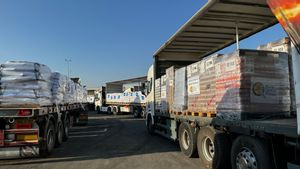JAKARTA - Today, it is the second anniversary of the COVID-19 pandemic in Indonesia. On March 2, 2020, the first COVID-19 case was recorded, indicating that the corona virus had entered the country.
The government has taken various measures to deal with the pandemic. However, there is one thing that has been highlighted by an epidemiologist from Griffith University Australia, Dicky Budiman, namely the problem of tracing cases.
Two years into the pandemic in Indonesia, according to Dicky, efforts to trace COVID-19 cases are still weak. This means that many people are still exposed to the virus from people who have been infected, but are not detected and recorded in case reports.
Some local governments also admit that their tracing efforts are still inadequate so far.
"Our ability to find cases in the community is still limited and there is still a big gap between cases found and reported and cases occurring in the community," said Dicky to VOI, Wednesday, March 2.
In fact, the central government has given a benchmark for each region to trace more than 15 close contacts per confirmed case.
Then, this identified close contact also needs to quarantine for at least 5 days, accompanied by a COVID-19 test during the quarantine period before the test results come out. If positive, the confirmed close contact must isolate.
Dicky stated that the weakness of tracing was evidenced by the condition of COVID-19 cases, the majority of which occurred through local transmission, from the beginning of the pandemic until March 2022.
"We know that from April 2020 to March 2022, we are still at the community transmission level. Which means that the epidemic or pandemic wave is still serious in the community," said Dicky. This pandemic is getting better. The policy of implementing restrictions on community activities (PPKM) is considered to be the most appropriate strategy to control COVID-19.
"The strategy is starting to appear even though it is learning by doing. It turns out that we know that PPKM is more effective because it is from above, there is also a lot of support, so there is no gap or disparity in regional capabilities, nor is it a political tool for some regions, although the risk communication strategy is still up and down and the policy changes frequently and is tight," he added.
The English, Chinese, Japanese, Arabic, and French versions are automatically generated by the AI. So there may still be inaccuracies in translating, please always see Indonesian as our main language. (system supported by DigitalSiber.id)









